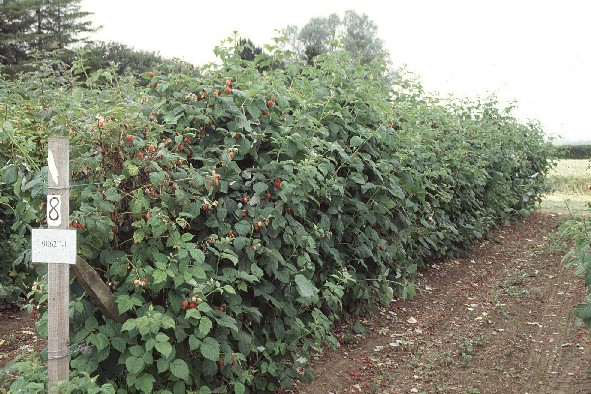Traditional methods
 In the traditional method of culture fruit is harvested annually, although both non-fruiting vegetative canes (primocanes) and fruiting canes (floricanes) are present. This main season summer-fruiting crop is usually supported on a post-and-wire system designed to carry the weight of fruits and to protect canes from excessive damage due to wind, harvesting and cultivation.
In the traditional method of culture fruit is harvested annually, although both non-fruiting vegetative canes (primocanes) and fruiting canes (floricanes) are present. This main season summer-fruiting crop is usually supported on a post-and-wire system designed to carry the weight of fruits and to protect canes from excessive damage due to wind, harvesting and cultivation.
Primocanes are produced in numbers excessive to requirements for cropping in the following season so many must be removed by pruning in winter and early spring to reduce inter-cane competition and create an open crop canopy for efficient light capture. Old dead fruiting canes must also be removed by pruning after harvest. Such pruning operations remove sources of fungal inoculum from the plantation and are important for the long-term health of the crop.
Organic production
There has been increased interest in the sale of raspberry fruits harvested from 'organic production' - farming based on methods relying entirely on crop rotation and avoidance of pesticide application except certain substances currently permitted by the national regulatory authority for organic farming. However, with woody perennial crops the difficulties of maintaining healthy productive plantations over many years are profound and it is too early to judge the overall success of these ventures in Rubus cane fruits.
Autumn-fruiting raspberries
Increasing popularity of autumn-fruiting raspberries, in which late season fruit is harvested from berries forming on the upper nodes of primocanes, has extended the production season and the period of attack of some foliar and cane pests. Some very early spring fruits with high value can also be obtained from the remaining lower nodes of these over-wintered primocane-fruiting types.
Primocane-fruiting raspberries tend to be grown in the warmer areas of Europe where the temperature in autumn is relatively high and there is little risk of early autumn frosts.
Extended season production
Interest has also been shown in extended-season production under glass or under plastic structures in northern European countries, e.g. Belgium (Meesters and Pitsioudis 1993; Verlinden 1995) and the UK (Barry 1995) and now in the Mediterranean fringe, e.g. Spain and Greece, and this trend will have implications for pest and disease control. Protected crops (grown under glass or plastic) can include those grown in field soil and also those grown in pots, generally referred to as 'long cane' and it is principally long cane that is being used for extended season production.
To satisfy such production systems, long primocanes grown in northern regions, such as Scotland, are lifted, chilled and stored for long periods for planting in late spring for late summer harvest under plastic. The concept of extended-season-production would mean that by careful manipulation of plant dormancy cycle and flower initiation it should be possible to produce fresh raspberries in the UK for sale in almost all months.
In experimental long-cane trials at the Institute, yields of up to 1 kg per cane have been achieved, but since commercial yields are not generally as consistently high, further work is required to advance the long-cane system.
